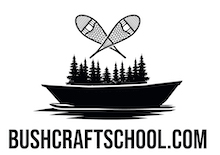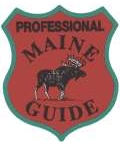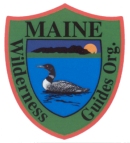My friend David Cronenwett is the co-owner of the Wilderness Arts Institute in Montana, an experienced bushcraft instructor and a professional naturalist. He sent me this essay he wrote about a winter survival exercise that became a wilderness survival episode last winter in Montana’s Bob Marshall Wilderness. It’s a good read and there are lessons to be learned from his experience
by David Cronenwett
Copyright 2008 – Reprinted With The Permission of the Author
I am always interested to hear the trials of outdoor-folk who run into adversity in the wild and learn how they cope and overcome. However, I’m much less enthusiastic about recounting my own such experiences, of which until January 2008, there had been few. In the spirit of honesty and my belief that we should all learn from our experiences in the wild, here’s my most interesting (read: dangerous) cold weather experience in the mountains of Montana, to date.
Last winter a friend and I snowshoed into the northern end of the Bob Marshall Wilderness, along the Middle Fork of the Flathead River. We planned to make this a “training trip”, where we’d work on some bushcraft skills for a couple days in the woods. It had finally become winter in Montana, with good snowpack and relatively cold temperatures.
The weather report warned that the coldest days of the year (around twenty-below zero without windchill) could be expected that weekend and anyone with some sense would be inside near the woodstove. Eric and I decided to head out anyway. I have been known to fiddle around with wilderness survival and felt that I hadn’t been putting in enough training time lately. Coincidentally, I had just given a lecture the night before about cold weather survival and had covered the essentials; let someone know where you’re going; dress in wool layers; know how to build a fire in any conditions; be competent with shelter-craft; control your mind. I knew the conditions on this trip could seriously challenge us, but felt that we were well prepared and could easily “bug out” if we needed to.
Eric, his dog Kira and I arrived relatively late in the day at the spot where the Middle Fork meets Highway 2. We headed up the river through 3 feet of snow in balmy 34-degree weather. We knew that come nightfall a winter storm would blow in and temperatures would collapse behind it. Since we weren’t out to cover ground but work on things like shelter building and firemaking, we decided that we’d make camp as soon as we could find one, even if it were close to the road.
One decision I knew could be pivotal for winter backcountry travel was my choice of footwear. Before we left the car, I decided to go with moosehide mukluks, instead of pack boots. Now, mukluks are well known to be the choice for dry-cold conditions, that is (arguably) about 20 degrees Fahrenheit and below. Although it was above freezing when we left, I reasoned that since I’d be on snowshoes for only a short distance and that dry cold was on the way, that I’d be fine. Please note mistake number one.
After about an hour of slogging, we came to a spot where the river tightened in its canyon, making further travel impossible on our side. There were however, a few iced-over sections of water, one of which spanned the stream where we found ourselves. I thought it looked sound, (mistake number 2!) and began to quickly shuffle across. As I came to the middle, the slushy ice gave way beneath my feet. Its hard to describe the slow motion-ness of that moment, except to say that the thought, “Damn, I’m going to have wet feet” quickly morphed into, “Oh my God, I’m submerged…” in just a few seconds. I was in good, up to my belly button, facing upstream. I had large, Green Mountain snowshoes on and a relatively large pack. My feet seemed to be resting on something solid, but when I removed my pack and therefore its flotation, whatever was holding me upright, collapsed and I sank in another six inches. Eric grabbed the pack and pulled it over to the bank.
I don’t much remember a sensation of cold, or any hyperventilation, which is what often happens in cold-water immersion cases. But the feeling of being sucked in, and pulled upstream in what was apparently the back eddy of a large pool, was terrifying. “It’s deep! It’s really fucking deep!!” I remember saying out loud, as if to convey to my partner that he should get me the hell out of that water right now. As Eric pulled me out, I prayed that the ice would hold our combined weight and remember feeling remarkably buoyant, considering the amount of soaked wool clothing I was wearing. Had I been alone, I doubt that I could have extricated myself from the current.
Once out, I quickly re-shouldered my pack and started moving. In a mildly freaked out state of mind, I thought that this would be a good test of our abilities, to try and get through a night of subzero cold, one of us having taken an unplanned dip in the mighty Middle Fork. I guess you could call that mistake number three.
We snowshoed downstream and made camp only a few minutes walk from the spot where I went in. There was abundant standing dead wood available and we set about getting a blaze going. We’d come over from the east side of the Divide for this adventure, a windy, dry place that lies in the rain shadow of the Rockies. And although it can be challenging to start a fire on the Rocky Mountain Front with its high winds, the constant freeze-thaw, rain-snow mix of the West side makes combustion notoriously difficult, even in good conditions. Of course, this is when that winter storm began to roll in. It began blowing and snowing like hell in the afternoon twilight, with us working on a shelter and trying to light up a fire.
Heavy snowpack made it impossible to move around without snowshoes. I sloshed about in my soaking wet mukluks gathering shelter materials and felling firewood. My feet were freezing. It took three major attempts to get that blaze going. Ultimately, it came down to birchbark and feather sticks; the nearly always reliable dry kindling of standing dead wood. Once it was clearly established, we amped up our gathering. We ended up burning material about 4-6 feet long and 6 to 8 inches in diameter. This was a relatively large winter fire. Eric was now about as soaked as I was from thrashing around in the wet-heavy snow, but had relatively dry feet from wearing pack boots. I spent a while trying to dry myself out, but we needed to get the shelter up and tarped over before darkness settled in.
We were now in blizzard conditions, and the temperature dropped precipitously. Due to our proximity to the highway-corridor, we could occasionally hear the Burlington-Northern Empire Builder en route to and from Seattle. The irony of our proximity to civilization juxtaposed with this sketchy situation was not lost on either of us. We were both wet and coated with ice (which I learned, works remarkably well at cutting wind), one of us (the survival instructor) had footwear that was nearly useless and it looked like the fire, which burned through several feet of snow to the ground, would not effectively warm our shelter. The angle was all-wrong and because of this the “greenhouse” couldn’t absorb direct radiant energy. We’d have to think on that one.
Its funny, when I went in to the water and after coming out, I never became remotely hypothermic or even uncomfortably cold. The only exception: my feet. But even though deeply chilled, they never became numb or frostbitten. While I wasn’t in a state of panic I have to admit being deeply shaken by unthinkable possibilities. What if I had been alone, would I have died or been more cautious and not gone out on the ice in the first place? What if we’d been five miles out and both of us had gone in and soaked our sleeping gear?
I can only attribute my relative physical comfort to highly insulative wool clothing and the subsequent wall of fire. My shook-up mental state was comforted by the inferno in front of me, the fact that we had sleeping bags, a warm dog and my remarkably enthusiastic friend. Looming in front of us though, were predicted overnight temperatures of 5 to 10 below zero. While Eric got dinner together, I stripped off my footwear again, changed socks and attempted to dry out. In the process, I torched a pair of thick wool socks and liners. I was thereby reduced to one pair of thin socks and the wool duffle mukluk liners. How many mistakes are we up to now?
We gratefully scarfed Eric’s venison-pork-couscous creation. There were countless things going through my head that evening; the simple gift of fire, the fragility of life, the nature of my relationship with the land, unrealized ambitions, my young son.
There’s nothing quite like being spiritually ass-whooped in the wilderness while arctic cold is descending upon you. My impulse was to slow down and try to process the experience. However, doing so would preclude helping with the ongoing firewood effort, which required our immediate attention. So I resisted wallowing in my emotions and tried instead to get shit done.
When it was simply too dark and cold to safely fell any more wood, we focused on dealing with the imperfect shelter situation. The fire was clearly not going to do much for us while we were inside. So we relied on limited heat from candles. Neither of us had sub-zero sleeping gear, a point that was immediately apparent shortly into our journey through the night and consequently, no one really slept. I never began to shiver, which is good, but was always on the verge for many hours.
Kira, the Catahoula-mutt whose thin-coated ancestors hail from the Deep South, was not as enthusiastic as she’d been earlier. Once she realized that this was not to be a simple day trip, reality set in. I caught a few glimpses of her by candlelight throughout the night. Curled up snout to tail, she stared back with a, “Surely-they-are-trying-to-kill-me”- look. Poor hound.
After the long night of semi-consciousness, we awoke to a frigid morning, everything inside the shelter encrusted in ice from condensation. Most of the clothing we’d removed before crawling into sleeping bags was frozen solid, but was put on anyway. We busted out a good blaze and I continued, once again, the mukluk thawing process. It was many degrees colder outside of the shelter. We immediately decided that enough was enough. There was another 6-plus inches of snow on the ground and enormous drifts everywhere. The ambient temperature was about -10F and with windchill, probably much lower. We also knew conditions would worsen when the bulk of the cold front filtered into the area. It was time to bug out. Kira found refuge in a tree well while we broke camp. Eric made a comment about her crawling away to die somewhere.
I pulled on the cold but relatively functional mukluks. The snow was deep and the wind howling. Kira was post-holing and could only walk out on our packed trail. More thoughts flooded in. In addition to my faulty judgment, we experienced a terrible combination of events: a warm day with sloppy, wet snow and a cold-water immersion incident followed by a snowstorm and Arctic cold. On top of this, a less than ideal shelter situation and a semi-immobile member of the party (me) conspired to create a potentially dangerous situation. However, we did keep our heads about us throughout the experience. In the back of my mind I believed we would have been able to make it out even in brutally cold conditions, since we were only a mile from the car. But this could have proved to be yet another dangerous assumption, beyond a certain threshold.
What did not happen on this excursion is also notable. There were no broken tools, no injuries of any kind, no hypothermia, no dead bodies. But I’ll tell you what, experiences like this make you think long and hard about things. It was still morning when we made it back to the road. In 30 minutes, we were at the East Glacier Grill devouring platefuls of hot, greasy goodness.
My friend Tim Smith from New Hampshire unintentionally summed up some of my complex feelings in a recent Jack Mountain Bushcraft Blog entry:
“Skill and experience can take you very far, but sometimes it can’t overcome bad conditions. In Caribou Hunter, Mathieu Mestokosho talked about how sometimes people went hungry. Not because they lacked hunting skills, but because that’s the reality of life.
Our media-saturated culture is TBH (Trained By Hollywood), where the hero always wins and things always turn out in the end. In the real world things don’t work like that. Experience teaches us humility, and that no matter how good you are, sometimes things won’t turn out how you want. The thing to take away from this is to have a healthy dose of reality in your assessment of your skill level, and to realize that sometimes, no matter how good you are, skill is not enough.”
Mercifully and despite a mild ass-kicking, neither Eric or I perished out there. More than anything, this experience reinforces my awe of and humility toward the land in what I can only describe as spiritual terms. Woodsfolk should always keep this in the fore of our minds: stay humble. Sometimes it doesn’t matter how good you are. Sometimes, you just die.
Postscript:
This past fall, my family and I hiked into the site where these events unfolded. It was a beautiful autumn day; low angle light, crisp, blue sky and mountains painted gold with larch. The whole scene appeared so innocuous, it was difficult to imagine the miserable situation caused by my own stupidity, ten months earlier. The river was lovely. I thought how this could easily have become a place of mourning to my loved ones for the rest of their lives and perhaps one of the few associations my 5 year old son would ever have of his father. Who knows how many places in Montana have hidden, tragic human stories associated with them? I considered the landscape and its deep memory.
While Hunter and his mother threw rocks in to the river, I sat alone at the camp; there were remains of the shelter here and there, and a small pile of spent coals. I was surprised at how little impact we’d made. After giving thanks for the blessings of life, I sawed off the few obvious stumps to the ground and neatly stacked, upright, the remaining firewood and shelter poles against a spruce. A winter traveler might need them some day. I left after grabbing a big handful of bark from a nearby birch.
David Cronenwett is a wilderness survival instructor and naturalist who lives in Choteau, Montana. He can be reached at: dcronenwett@wilderness-arts.com.







